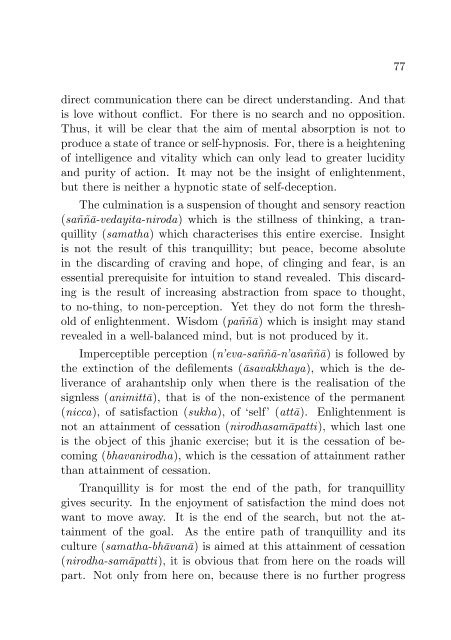Agony and Ecstasy
A comparative study of the five hindrances, together with the five states of concentration or mental absorption.
A comparative study of the five hindrances, together with the five states of concentration or mental absorption.
You also want an ePaper? Increase the reach of your titles
YUMPU automatically turns print PDFs into web optimized ePapers that Google loves.
77<br />
direct communication there can be direct underst<strong>and</strong>ing. And that<br />
is love without conflict. For there is no search <strong>and</strong> no opposition.<br />
Thus, it will be clear that the aim of mental absorption is not to<br />
produce a state of trance or self-hypnosis. For, there is a heightening<br />
of intelligence <strong>and</strong> vitality which can only lead to greater lucidity<br />
<strong>and</strong> purity of action. It may not be the insight of enlightenment,<br />
but there is neither a hypnotic state of self-deception.<br />
The culmination is a suspension of thought <strong>and</strong> sensory reaction<br />
(saññā-vedayita-niroda) which is the stillness of thinking, a tranquillity<br />
(samatha) which characterises this entire exercise. Insight<br />
is not the result of this tranquillity; but peace, become absolute<br />
in the discarding of craving <strong>and</strong> hope, of clinging <strong>and</strong> fear, is an<br />
essential prerequisite for intuition to st<strong>and</strong> revealed. This discarding<br />
is the result of increasing abstraction from space to thought,<br />
to no-thing, to non-perception. Yet they do not form the threshold<br />
of enlightenment. Wisdom (paññā) which is insight may st<strong>and</strong><br />
revealed in a well-balanced mind, but is not produced by it.<br />
Imperceptible perception (n’eva-saññā-n’asaññā) is followed by<br />
the extinction of the defilements (āsavakkhaya), which is the deliverance<br />
of arahantship only when there is the realisation of the<br />
signless (animittā), that is of the non-existence of the permanent<br />
(nicca), of satisfaction (sukha), of ‘self’ (attā). Enlightenment is<br />
not an attainment of cessation (nirodhasamāpatti), which last one<br />
is the object of this jhanic exercise; but it is the cessation of becoming<br />
(bhavanirodha), which is the cessation of attainment rather<br />
than attainment of cessation.<br />
Tranquillity is for most the end of the path, for tranquillity<br />
gives security. In the enjoyment of satisfaction the mind does not<br />
want to move away. It is the end of the search, but not the attainment<br />
of the goal. As the entire path of tranquillity <strong>and</strong> its<br />
culture (samatha-bhāvanā) is aimed at this attainment of cessation<br />
(nirodha-samāpatti), it is obvious that from here on the roads will<br />
part. Not only from here on, because there is no further progress

















